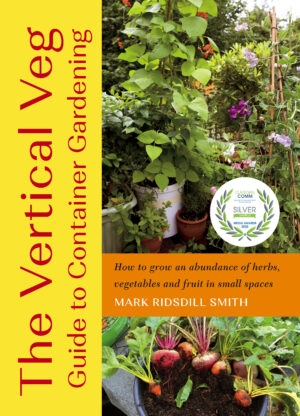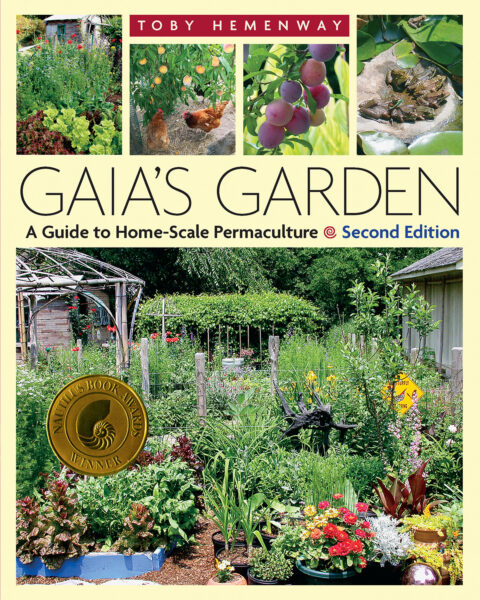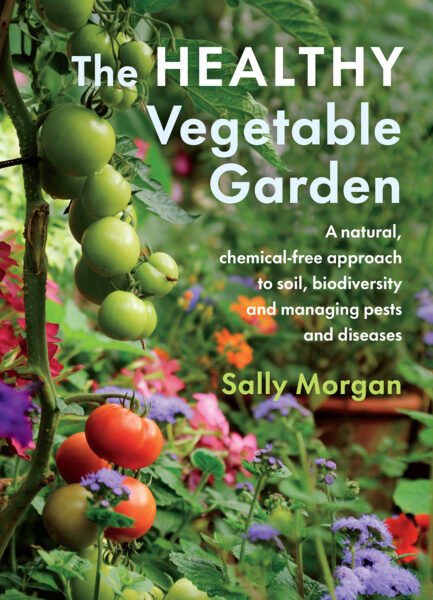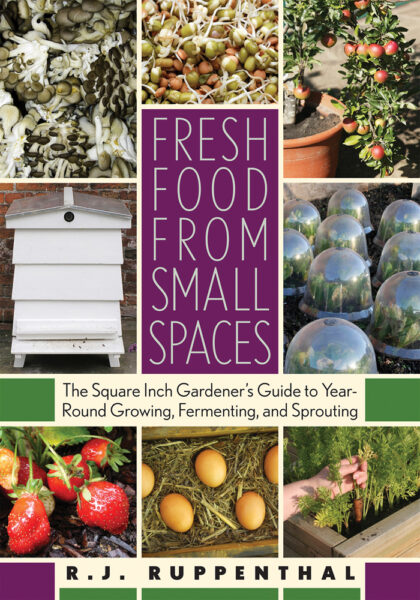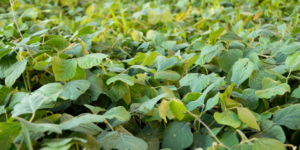How to Design Your Own Container Garden
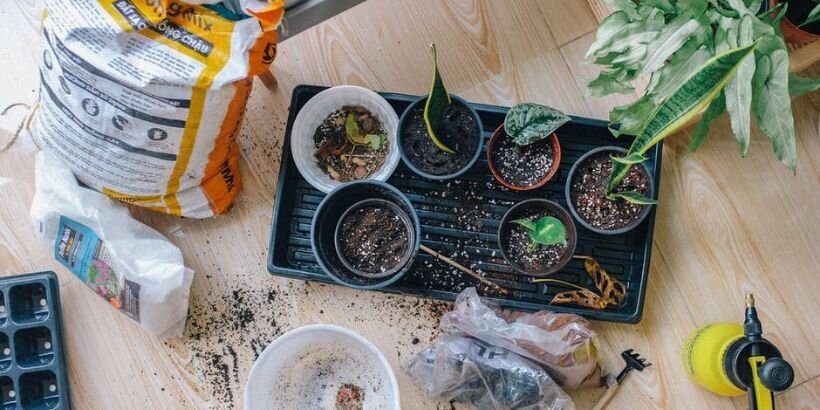
Want to create your own garden, but don’t think you’d have the room for it? Think again.
According to Mark Ridsdill Smith, author of The Vertical Veg to Container Gardening and creator of the Vertical Veg website, almost any small space can transform into a garden with a little bit of soil, seeds, and inspiration. In his book on vertical gardening, Mark gives readers step-by-step instructions on how to turn an area as tight as a window box into a beautiful and plentiful container garden.
The following is an excerpt from The Vertical Veg Guide to Container Gardening by Mark Ridsdill Smith. It has been adapted for the web.
Unless otherwise noted, all photographs copyright © 2022 by Mark Ridsdill Smith.
When starting a new container garden, the first thing is to get to know your growing space, particularly how much sun it gets, and then to start growing in a few pots. As well as gaining valuable experience, this will help you to learn what grows well in your space – and to plan how you might develop your container garden in the future.
Sun, Wind and the ‘Microclimate’
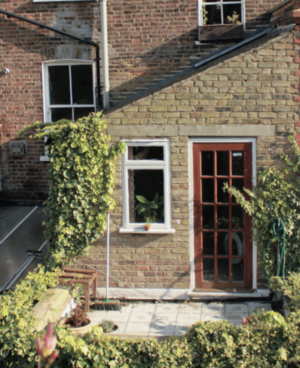 Each urban space has its own unique microclimate, which is determined by how much sun it receives, how sheltered it is, and how much heat is reflected from surrounding bricks. Different growing spaces in the same street – even in the same home – can have quite different microclimates.
Each urban space has its own unique microclimate, which is determined by how much sun it receives, how sheltered it is, and how much heat is reflected from surrounding bricks. Different growing spaces in the same street – even in the same home – can have quite different microclimates.
The microclimate will affect how easy it is to grow in a space and what will grow well. Many urban spaces have excellent microclimates for growing, while others are trickier. Learning about yours will help you choose the most suitable crops and then to grow them more successfully.
The first and most important task is to observe how much sun your space gets, as this will have the most impact on what you can grow…Once you start growing, you will continue to learn as the seasons roll round. Try to observe how the sun and wind patterns shift. Which areas get the most and least sun in spring, summer, autumn and winter? Does wind usually come from the same direction or does it change through the year? How often do different areas get frost in winter?
The key factors that affect growing are:
Sun and light levels: These are critical and looked at in detail in the next chapter. As well as direct sun, reflected light also makes a difference. If your space doesn’t get much sun, there are ideas on what you can do in Chapter 11 Solutions to Common Challenges, ‘Too little sun: shady spaces’, page 241.
Wind: Most plants don’t grow well in strong or persistent winds. Some rooftops and balconies are exposed, and even patios and front yards can sit in wind tunnels created by surrounding buildings. If you find that wind is an issue, there are often ways to minimise it and grow successfully. For further advice, see Chapter 11 Solutions to Common Challenges, ‘Wind’, page 239.
Temperature: In general, while the sun is good for growing, excessive heat can cause stress to plants and make pots dry out faster. This will be a familiar issue for anyone growing in hot or tropical climates, but small spaces surrounded by concrete can become heat traps in summer even in temperate climates. For tips on how to deal with excessive heat, see Chapter 11 Solutions to Common Challenges, ‘Too hot: suntraps, hot climates and heatwaves’, page 242.
Design Questions
In addition to the microclimate, here are some questions and practicalities to consider when designing a larger container garden.
What do you want to get out of your container garden?
Every container garden is unique and each of us has a different set of motivations for wanting to start one. The simple pleasure of growing is as good a reason as any. Here, to offer a few ideas, are some of the possibilities. None of them are mutually exclusive – a container garden can help you realise all of these:
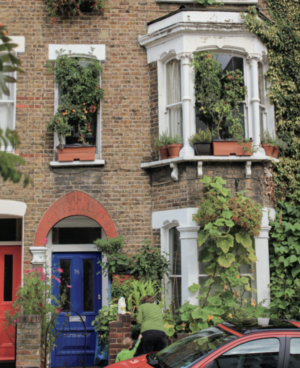 Beauty: There are many pretty edibles such as nasturtiums, lavender, runner beans and ‘Cavolo Nero’ kale.
Beauty: There are many pretty edibles such as nasturtiums, lavender, runner beans and ‘Cavolo Nero’ kale.- Salad self-sufficiency: Homegrown salad tastes so much better than supermarket leaves, and it’s possible to be self-sufficient in salad with just a few containers.
- Food with more flavour: You can eat fresh herbs with every meal, expand your larder with exotic edibles and enjoy the unsurpassed flavour of freshly picked, homegrown chillies and tomatoes.
- Good health: Choose nutritious foods like kale, blueberries and microgreens. Attract wildlife: Grow flowers to support pollinators, create birdbaths and basin ponds, and provide homes for solitary bees.
- Enjoy scent: This is often overlooked but our sense of smell is one of our most evocative senses. Lavender, mint and roses are among the fragrant plants suitable for containers.
- Grow speciality foods: If you like a particular cuisine or style of cooking, you can grow the fresh ingredients, whether these are Jamaican vegetables, Asian herbs, or vegetables and sprouts to support a raw-food or plant-based diet.
- Save money: By choosing what you grow and caring for it carefully, you can cultivate many ingredients at home for a fraction of the price of shop-bought produce.
- Be more sustainable: If you build using recycled materials, collect rainwater, recycle food waste to make compost, and save seed, you’ll be creating a garden with greater sustainability.
Where is the nearest water source?
Watering is the most time-consuming part of container growing. For larger container gardens, it will save a lot of time if you have a water source close to the plants. Where possible, an outside tap or a water butt is ideal. If this isn’t feasible, neat and compact mini hose reels, run from an indoor tap, can offer a good alternative.
What about storage space?
Where will you store tools, fertiliser and compost? Sometimes, it’s possible to squeeze in new storage areas when you design a space. For example, the space under a shelf for pots can be used for storage or a large box can double up as a bench and storage space.
How many pots?
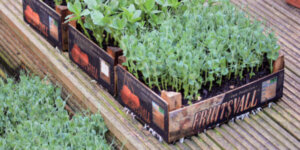 One of the unwritten rules of container gardening is that there is always (or nearly always) space to squeeze in another pot. This is all part of the creative fun. But sometimes it’s possible to end up with more pots than you can easily look after.
One of the unwritten rules of container gardening is that there is always (or nearly always) space to squeeze in another pot. This is all part of the creative fun. But sometimes it’s possible to end up with more pots than you can easily look after.
There are no rules about the ideal number of pots, and often the size of your space and the amount of time you have will be the limiting factors. As a guide, though, aim for enough pots to make your container gardening and the effort feel worthwhile. It’s common to find that the more you invest in a container garden, the more rewarding growing becomes (and the easier it is to remember to water – there is less incentive with just one or two pots).
At the same time, it slightly defeats the point if you get stressed by having too many pots to look after. Luckily, container gardens can easily be made smaller as well as larger. If you are starting your first container garden, I recommend adding a few containers each year, gradually increasing the number as you learn. However, if you have an urge to create a container empire straight-away, don’t let me hold you back: it can be fun! Just be aware that there is more risk of buying pots or plants that you discover aren’t ideal later.
Temporary or long-term?
How long you plan to stay in your home will influence your approach to container gardening. You can think longer term in more permanent homes – planting fruit trees that take several years to be productive, for example. Container gardens can be equally rewarding in short-term accommodation, but you’ll want to design them with the likely length of your stay in mind.
How often and how long will you be away?
Plants in containers need regular attention. If you go away regularly or for long periods, you can plan for this. You might have a neighbour or a friend who will be happy to water for you in exchange for picking rights. Or you can look at ways to reduce the amount of manual watering needed or just opt for fast crops such as microgreens during the periods you are at home.
Any special requirements?
Container gardens can be designed to meet specific needs such as wheelchair access. Heights can be adjusted by fixing containers to a wall at the required level or putting them on pallets or strong plastic boxes.
A quick word on ‘beauty’
Gardening programmes and magazines often focus on perfection. But, from working with hundreds of container gardeners, I’ve learnt that you don’t need an aesthetically pleasing or aspirational ‘lifestyle’ garden to get a lot out of growing.
Still, even if you don’t aspire to the perfection of lifestyle magazines or Instagram, you’ll probably want your growing space to look as attractive as you can and it’s still possible to create a beautiful container garden even when using recycled materials.
If your container garden is in a publicly visible space, a pretty collection of pots and planters will also inspire others and be an asset to the community.
Organic growing?
There are several approaches to growing, such as organic, biodynamic and permaculture, that can provide useful ideas and principles for container growing in the city. If you choose to follow one, bear in mind that it may not be easy to apply all its principles.
For example, it may not be practical to make large volumes of compost or weed teas in a small space. Rather than rigidly following the rules of any particular system, I find it more helpful to draw on a wide range of ideas while focusing on principles that nurture all life. It’s also important to acknowledge that many ‘modern’ organic growing methods – and most permaculture design principles – have their roots in ideas pioneered over thousands of years by indigenous peoples in Africa, Asia and around the world. Here are some of the principles I follow:
- I completely avoid the use of pesticides, including ‘natural’ pesticides that contain ingredients like chilli or garlic (any mixture that kills one insect will kill others, too).
- I use homemade fertiliser as much as possible and supplement with purchased fertiliser based on natural ingredients (like seaweed or chicken manure) when needed.
- I recycle and compost as much garden and food waste as I can.
- I’m happy to share a proportion of my harvests with other animals – birds and caterpillars, etc – so my growing efforts help to feed the wider ecosystem.
- I grow a diverse range of plants, including flowering plants, to support pollinators.
- I try to grow open-pollinated plants as much as possible and limit the number of F1 hybrids.
You’ll need to consider what is important to you and work out your own principles, bearing in mind what is realistic given the space, time and budget you have. But you can be confident that if you avoid using poisonous chemicals in pesticides, you will create more life and biodiversity in the city, however you grow and whichever approach or principles you adopt.
Draw a plan
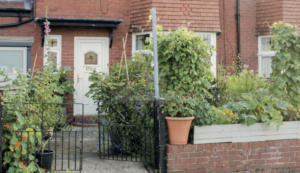 Once you’ve observed the sun in your space, worked out what you want to grow and thought through the practical considerations, you may find it helpful to draw a plan. A plan will help you work out how to arrange your growing space aesthetically and practically. It can be a rough sketch to help you think through ideas or a neat plan drawn to scale.
Once you’ve observed the sun in your space, worked out what you want to grow and thought through the practical considerations, you may find it helpful to draw a plan. A plan will help you work out how to arrange your growing space aesthetically and practically. It can be a rough sketch to help you think through ideas or a neat plan drawn to scale.
On your plan, first mark the sunniest and least sunny places. Put crops like tomatoes in the sunniest places. Wormeries, water butts and storage boxes can go in shady areas. If you draw and cut out scaled pictures of your pots, wormery and furniture, you can move these around on your plan like a jigsaw to find the best arrangement.
When working out what to put where, try to think of your space in three dimensions – as a cube rather than a flat space. How can you make best use of all the space in the cube? Where can you grow climbers, add hanging baskets or put shelves? Can you attach strings anywhere to support climbers?
Safety Considerations
Overall, the potential benefits of urban growing far outweigh the risks. But it’s still useful to be aware of the risks, so you can assess them carefully.
1. Weight of Pots
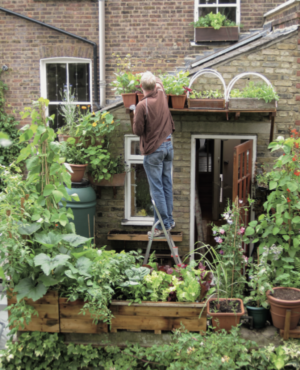 Pots and soil, particularly when waterlogged, can be very heavy to lift and move. Their combined weight and where they are placed is also critical. This is particularly important on balconies and rooftops. A collapsing roof is a real and serious risk.
Pots and soil, particularly when waterlogged, can be very heavy to lift and move. Their combined weight and where they are placed is also critical. This is particularly important on balconies and rooftops. A collapsing roof is a real and serious risk.
The number and size of pots you can safely have will depend on the design and construction of the building. The only way to be certain is to consult the architectural plans for the weight-bearing load or to hire a structural engineer to advise you.
If this is not viable, err on the side of caution. Use small, lightweight plastic pots and lightweight soil mixes. You should also avoid large pots completely or place them on top of a load-supporting wall. Try to attach some planters directly to walls, where possible, to reduce the load on the floor.
Moving heavy bags of compost and pots is also an issue to consider for those with back problems or mobility issues. Choosing lightweight materials and using a trolley or a dolly to shift heavy pots can help.
2. Pots Falling Off
Check that any pot on a windowsill or ledge is secured so that it can’t fall or be blown off. Falling pots are potentially lethal and can also damage property.
Specialist gardening suppliers sell brackets and attachments for fixing contain- ers in place. A DIY solution on windowsills is to screw strong metal eyes into the wall on each side of the window (you’ll need a drill and wall plugs), an inch or two below the top of the window box. You can then secure the window box by tying a strong metal wire between the two eyes and tightening it around the window box until it is firmly secured.
3. Air Pollution
Rising air pollution is a concern in many urban areas. However, unless you live right next to a very busy road, the available evidence suggests that the risk to food growing is low to negligible…If your home faces onto roads with very heavy traffic, try and grow at the back of the house or behind a wall or hedge, if possible.
4. Soil Pollution
If you buy compost from a reputable company, it should have been tested for any pollutants. Green compost, made from garden and food waste (and sometimes called municipal compost), should have been tested, but check with your local supplier.
Soil pollution becomes more of an issue if you dig up garden soil to add to a potting mix. The soil in urban areas is often contaminated by past industrial activity. Even if it isn’t toxic, it is often of poor quality and can be mixed with builders’ rubble. You can sometimes get maps from the local environment agency that show areas with known polluted soil or you can pay to get soil tested.
Recommended Reads
Recent Articles
Everyone loves a refreshing, fermented, nutritious drink…even your garden! Take your fermentation skills out of the kitchen and into the garden by brewing fermented plant juice. The following is an excerpt from The Regenerative Grower’s Guide to Garden Amendments by Nigel Palmer. It has been adapted for the web. How to Make Fermented Plant Juice Fermented…
Read MoreWant to see your crops thrive this upcoming growing season? The key is in soil fertility and health. Spend time maintaining your soil’s health to guarantee bigger and better crops come harvest time! The following is an excerpt from No-Till Intensive Vegetable Culture by Bryan O’Hara. It has been adapted for the web. What Is Soil Fertility?…
Read MoreIt’s time to take control of your seeds and become a plant breeder! Saving your seed allows you to grow and best traditional & regional varieties, and develop more of your own. The following excerpt is from Breed Your Own Vegetable Varieties by Carol Deppe. It has been adapted for the web. Becoming A Plant…
Read MoreRewilding is one of the best things you can do for the biodiversity of your farm or garden. By no longer mowing your lawn, flowers will start to grow, creating a meadow and a habitat for creatures that often get forgotten. The following is an excerpt from The Healthy Vegetable Garden by Sally Morgan. It…
Read MoreTrying to figure out how to manage weeds in your garden beds? Use cover crops and living mulches for weed suppression while your garden flourishes! The following is an excerpt from The Ecological Farm by Helen Atthowe. It has been adapted for the web. Suppressing Weeds With Cover Crops: Getting Started Cover crops suppress weeds…
Read More

